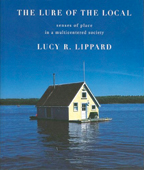 |
Lucy Lippard, The Lure of the Local. Senses of Place in a Multicentered Society. New York: New Press 1998.
Lucy Lippard’s stories and thoughts, readings and photos called my “senses of place,” clearly defined terms like “center,” “periphery” and “nature,” into question. I read this book as a remedy for the increasing restlessness of that rootless art crowd, of which I’m—nolens volens—part of.
Lippard draws unexpected connections between cultural studies and landscape, history, geography, contemporary art and the people of her chosen homes in the extreme North and the extreme South of the United States: Maine and New Mexico. Far beyond contemporary art issues, she illustrates how the use and perception of land changes the landscape, and how landscape influences cultural habits and, in the end, the everyday life of its inhabitants. The thoughtful and beautiful layout of this book reveals the many layers of interrelation between emotional, scientific, aesthetic and economical approaches to certain territories in the U.S.
|